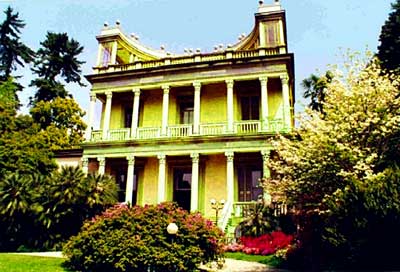|
Integrated TRADITIONAL Medicines OBJECTIVES | PROGRAMME | ORGANISERS | SPEAKERS | Announcement | THE VERBANIA DECLARATION PHOTO | MEDIA | SPONSORS & PATRONS | HOME | SEARCH | WORLD PEACE CONGRESS | SITE MAP
|
|
VILLA GIULIA The history of Villa Giulia is closely linked to the Branca family. In 1878, Cavalier Giuseppe Branca bought back from General Müller the building his father, Bernardino Branca, had built in 1847. (Bernardino Branca had invented in 1836 what was to become one of the most famous Italian liqueurs, Fernet.) His son called the mansion “Villa Giulia” after his wife, and by buying up adjacent land proceeded to extend the property, also in the direction of the lake. This project was the source of some expensive annoyance for the Cavaliere, as the first containment wall built collapsed into the lake in 1879, taking with it an imposing flight of steps, the remains of which can still be seen when the water in the lake is low. A second project, supervised by Dr. Gallizia, the Chief Civil Engineer of Milan, was more successful. The lake bottom was dredged down to the solid rock, on which the foundations for the containment wall of the garden were eventually built. Meanwhile, Cavalier Branca engaged the Milanese architect Giuseppe Pirovano to draw up the plans for improving the property. First of all an imposing entrance gate was constructed, then the wet basin, on top of which a terrace with an arbour and a garden were laid out, and artificial grottoes created. A gatehouse, later turned into an elegant billiard hall, was built at the entrance. The already beautiful garden was landscaped in the English fashion. Finally, in 1882, Branca turned his attention to the paternal mansion. The building was enlarged, with the façade extended a good ten metres towards the lake, and embellished with open galleries and columns on every storey; the finishing touch was a large circular terrace. This side of the villa is in sharp contrast with the side facing the road, which is plain and austere, almost with a “medieval” look. In 1904, Giulia, now widowed and remarried to Count Melzi d’Eril, made further improvements to the house, adding to the interior decoration elements of the Art Nouveau style then in vogue. In December 1932 Villa Giulia was bought by the Tourist Board with the intention of giving Pallanza a Municipal Casino and multi-purpose “Visitors’ Centre”. Thus Villa Giulia became the Kursaal (Casino), extended in 1955 with the creation of two spacious halls, one in the basement, accessible from the garden, and the other on the first floor, to be used for conferences, exhibitions and concerts. In
1959, part of the wet dock was converted into street-level premises to
house the Tourist Office. This meant eliminating the artificial grottoes
created by Pirovano as a decorative feature of In 1987, following a reorganisation of the administration of tourism, the Piedmont Region handed over Villa Giulia and its park to the Town of Verbania. The villa and its garden are currently used for conferences, concerts and cultural events of various kinds. |
|
|
